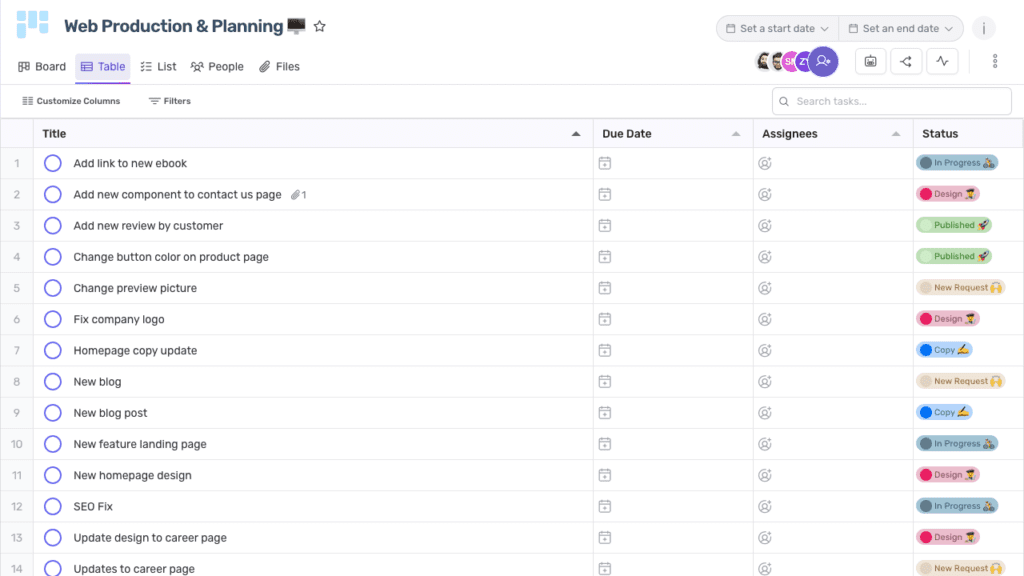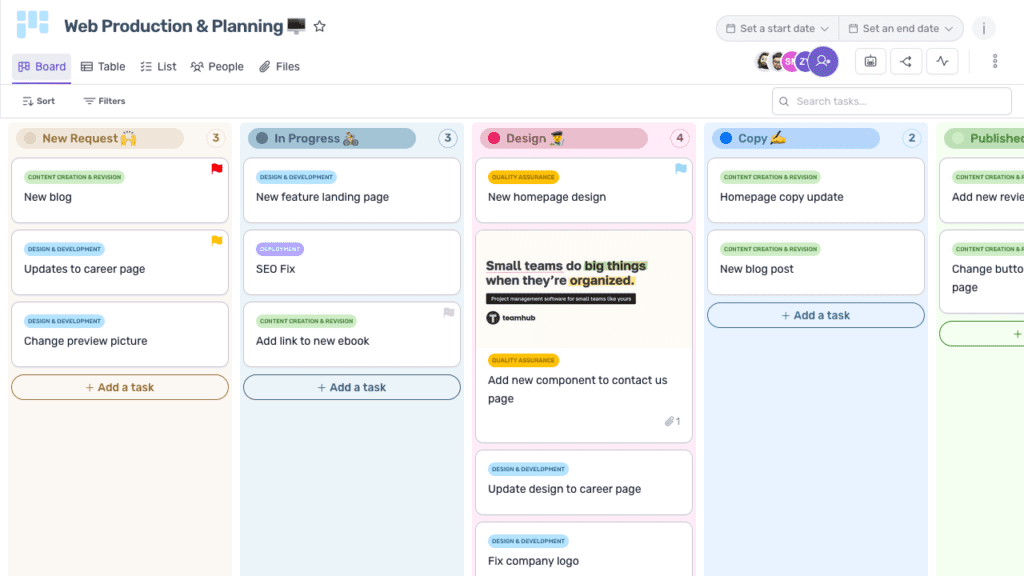In today’s fast-paced digital landscape, efficiency is paramount when it comes to web production. Meeting deadlines, managing resources, and maintaining a consistent brand identity are just a few of the challenges that web production teams face on a daily basis. However, with the right tools and processes in place, these challenges can be overcome. This is where a web production template comes into play.

Understanding the Importance of Streamlining Web Production
The role of efficiency in web production cannot be overstated. It not only ensures that projects are completed on time and within budget, but it also allows teams to focus their energy on creative aspects rather than getting bogged down by repetitive tasks.
The Role of Efficiency in Web Production
Efficiency is the driving force behind successful web production. It enables teams to work more productively by providing a standardized framework that streamlines the entire process, from ideation to deployment. By eliminating unnecessary steps and automating routine tasks, efficiency becomes the catalyst for higher-quality output.
Key Benefits of Streamlining Your Web Production

There are several benefits to streamlining your web production process. Firstly, it reduces the likelihood of errors and inconsistencies by providing a structured approach to project management. Secondly, it improves collaboration by ensuring everyone is on the same page and following the same procedures. Lastly, it saves time and resources, allowing teams to deliver projects more efficiently.
Moreover, streamlining web production can enhance scalability. A well-organized process allows for easier scaling of projects, whether it’s increasing the size of the team or expanding the scope of the project. This scalability is crucial for accommodating growth and adapting to changing business needs without causing disruptions in the workflow.
Implementing Efficient Tools and Technologies
Another aspect to consider when streamlining web production is the utilization of efficient tools and technologies. Implementing project management software, version control systems, and automated testing tools can further optimize the workflow. These tools not only improve efficiency but also enhance communication and transparency within the team.
Introducing the Web Production Template
The web production template is a pre-designed framework that serves as a blueprint for your web production process. It provides a structured system that guides you through each stage of your project, ensuring that nothing is overlooked and that each task is carried out efficiently.
Having a well-thought-out web production template can significantly enhance the overall workflow and organization of your project. It acts as a roadmap, helping you navigate the complexities of web development with ease and precision.
What is a Web Production Template?
A web production template is a collection of predefined guidelines, checklists, and tools that help streamline the web production process. It includes step-by-step instructions, timelines, and resource allocation plans to ensure that projects are completed smoothly and in a timely manner.
By utilizing a web production template, you can standardize your processes, improve collaboration among team members, and increase the efficiency of your web development projects. It serves as a centralized hub where all project-related information and resources are consolidated for easy access and reference.
Features of an Effective Web Production Template
An effective web production template should include the following features:
- Clear and concise instructions for each task
- Timelines and milestones to track progress
- Checklists to ensure that all necessary steps are completed
- Allocation of resources and responsibilities
- Space for documenting feedback and revisions
Additionally, a robust web production template should also incorporate flexibility to accommodate unforeseen changes or requirements that may arise during the course of the project. This adaptability ensures that your team can respond effectively to challenges and modifications without disrupting the overall workflow.
How to Use the Web Production Template
Now that you understand why a web production template is essential, let’s explore how to effectively use it to power up your web production process.
Before we dive into the step-by-step guide, let’s take a moment to appreciate the beauty of a well-structured template. Just like a blueprint for a magnificent building, a web production template provides you with a solid foundation to create a stunning website. It streamlines your workflow, ensures consistency, and saves you precious time and effort.
Step-by-Step Guide to Using the Template
1. Familiarize yourself with the template: Take the time to understand the structure and layout of the template. Pay attention to the instructions and recommendations provided. Think of it as getting to know the layout of a new city before you start exploring its hidden gems. The more you familiarize yourself with the template, the easier it will be to navigate through your web production journey.
2. Customize the template: Tailor the template to meet the specific needs of your project. Just like a skilled tailor who crafts a bespoke suit, you have the power to transform the template into a perfect fit for your website. Make sure to update any placeholders with relevant information, such as your brand colors, logo, and content.
3. Assign responsibilities: Clearly define roles and responsibilities for each team member. Imagine your web production process as a well-orchestrated symphony, with each team member playing their part to create a harmonious masterpiece. By assigning responsibilities, you ensure that everyone understands their tasks and deadlines, fostering a collaborative and efficient environment.
4. Follow the timeline: Utilize the timeline provided in the template to manage your project’s progress. Think of it as a compass that guides you through the vast ocean of web production. Regularly review and update it as needed, ensuring that you stay on track and sail towards success.
5. Document feedback and revisions: Use the space provided in the template to document any feedback, revisions, or changes that occur throughout the project. Think of it as a journal that captures the evolution of your website. By documenting feedback and revisions, you create a valuable record that helps you learn from past experiences and improve future projects.
Tips for Maximizing the Use of Your Template
1. Communicate effectively: Ensure that all team members are informed about the template and its purpose. Encourage open communication to address any questions or concerns. Just like a well-conducted conversation, effective communication fosters understanding, collaboration, and ultimately, success.
2. Regularly update the template: As the project progresses, make sure to update the template accordingly. This will help you track the project’s status and ensure that everyone is on the same page. Think of it as a living document that grows and evolves with your project, reflecting the dynamic nature of web production.
3. Continuously improve: After each project, gather feedback from your team on the effectiveness of the template. Use this feedback to make necessary improvements and optimize your future web production processes. Remember, just like a skilled craftsman who hones their skills over time, your web production process can always be refined and enhanced.
So, armed with this comprehensive guide, go forth and embrace the power of the web production template. Let it be your trusted companion as you embark on the journey of creating remarkable websites that captivate and inspire.
Customizing Your Web Production Template
One of the advantages of using a web production template is its flexibility. You can easily adapt it to suit the unique needs of your project. Whether you are working on a small-scale website or a large-scale web application, a well-customized template can streamline your production process and enhance the overall quality of your project.
When delving into customizing the template, it is essential to consider various factors that can impact the outcome of your project. These factors include the project’s size and complexity, the resources available to you, the specific requirements set by your client, as well as the deadlines and milestones you need to meet. By carefully analyzing and incorporating these elements into your template customization process, you can ensure that the final product is tailored to your project’s needs and sets you up for success.
Adapting the Template to Your Project Needs
When customizing the template, consider the following factors:
- Project size and complexity
- Available resources
- Client requirements
- Deadlines and milestones
By taking these factors into account, you can create a tailored template that maximizes efficiency and meets the specific demands of your project.
Ensuring Your Template Reflects Your Brand Identity
Your web production template should align with your brand identity. Incorporate your brand’s colors, fonts, and logo to create a cohesive look and feel. This ensures that your template not only serves as a functional tool but also represents your brand in a professional manner. Consistency in branding across all digital touchpoints is crucial for building brand recognition and trust among your audience.
Maintaining and Updating Your Web Production Template
Maintaining and updating your web production template is crucial to its long-term effectiveness. Regular maintenance helps ensure that your template remains relevant and continues to meet your evolving needs.
One key aspect of maintaining your web production template is to regularly back up your files. By creating backups, you can safeguard your template and all its associated data from unexpected technical issues or data loss. Consider storing your backups in a secure cloud storage solution to ensure easy access and peace of mind.
Regular Maintenance for Optimal Performance
Perform regular maintenance on your template by reviewing and updating it periodically. Remove any outdated information, replace broken links, and address any issues that may arise. This will help keep your template functioning smoothly.
Another important aspect of maintenance is to conduct usability testing on your template. Solicit feedback from users or team members to identify any pain points or areas for improvement. By incorporating user feedback, you can enhance the user experience and overall effectiveness of your web production template.
Updating Your Template as Your Needs Evolve
As your web production needs evolve, it’s important to update your template accordingly. Take time to evaluate your processes and identify areas for improvement. Incorporate any new tools or technologies that can enhance your web production workflow.
Furthermore, consider implementing version control for your template to track changes and collaborate more effectively with team members. Version control systems like Git allow you to manage updates, track revisions, and work on different features simultaneously without the risk of conflicts.
In conclusion, streamlining your web production project is essential for success in today’s fast-paced digital landscape. By utilizing a web production template, you can ensure efficiency, consistency, and quality throughout your projects. Take the time to customize and maintain your template to suit your unique needs, and enjoy the benefits of a streamlined web production process.
Ready to take your web production to the next level? Teamhub is here to elevate your team’s collaboration and streamline your projects from start to finish. With our centralized hub for Projects and Documentation, you’ll find everything you need to stay organized and efficient. Start your free trial today and join the thousands of companies enhancing their productivity with Teamhub!